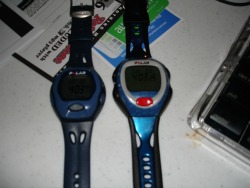
When it comes to fitness devices, most of us are probably more familiar with the benefits of a pedometer than a heart rate monitor. But you might want to consider investing in one, if you want to improve your fitness even more.
Exercise is about more than just how often you do it and for how long. The level (or intensity) of the exercise is just as important.
A heart rate monitor can keep track of your heartbeats, allowing you to stay in the appropriate heart rate zone. In other words, you don’t want the intensity of your exercise to be so low that it isn’t impacting your body. But you don’t want it to be so high that it becomes dangerous.
The American Heart Association has some general guidelines that can help you determine your optimum heart rate zone (HRT). Keep in mind that you should talk to your doctor about this first, as certain medications and health conditions may impact it. Your physician might have you undergo a stress test first.
The following are general guidelines for a heart rate target zone 50-85%:
- Age 20 – 100 to 170
- Age 25 – 98 to 166
- Age 30 – 95 to 162
- Age 35 – 93 to 157
- Age 40 – 90 to 153
- Age 45 – 88 to 149
- Age 50 – 85 to 145
- Age 55 – 83 to 140
- Age 60 – 80 to 136
- Age 65 – 78 to 132
- Age 70 – 75 to 128
The following are general guidelines for a heart rate target zone at maximum 100%:
- Age 20 – 200
- Age 25 – 195
- Age 30 – 190
- Age 35 – 185
- Age 40 – 180
- Age 45 – 175
- Age 50 – 170
- Age 55 – 165
- Age 60 – 160
- Age 65 – 155
- Age 70 – 150
In my next blog, we will be looking at the different types of heart rate monitors available and who would benefit from having one.

